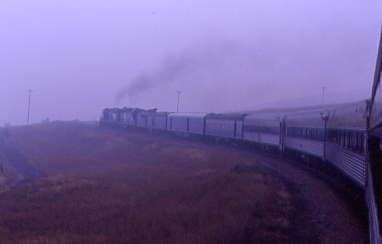
Following another continental breakfast then watching ESPN's Sports Center, we went down and boarded the buses for the train. It was still very wet and overcast but with less smoke.
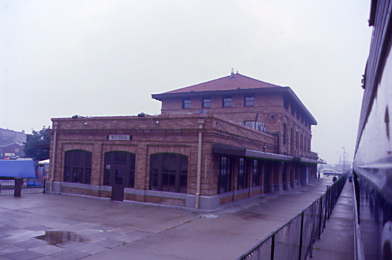
The Northern Pacific Missoula station.
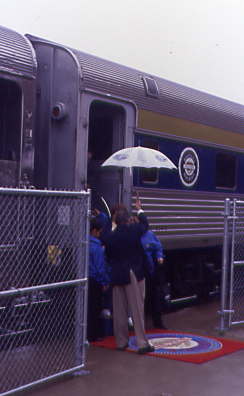
Today we boarded Montana Daylight coach 4700 "Tohatchi", ex. Amtrak 4700, exx. Amtrak 4817 1980, nee Santa Fe 48-seat chair car 2823 built by Budd Company in 1953, under cover of an umbrella. We departed at 8:07 AM and passed the Montana Rail Link engine facility then the south side of their Missoula yard.
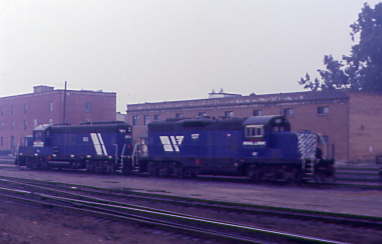
Montana Rail Link GP9's.
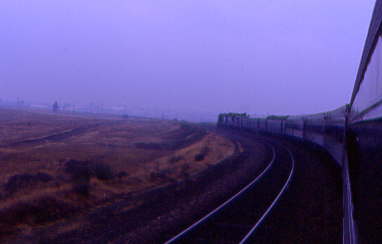
Rolling through the smoky Missoula Valley, the crew announced that we would be running over Evaro Hill this morning.
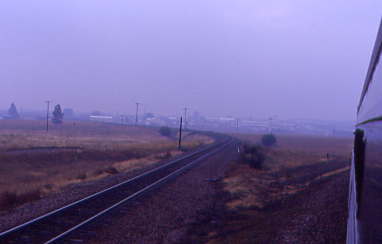
We went through De Smet, Milepost 125.9, the junction with the 10th Subdivision, with the line via St. Regis branching off to the left, and started the two percent grade up Evaro Hill.
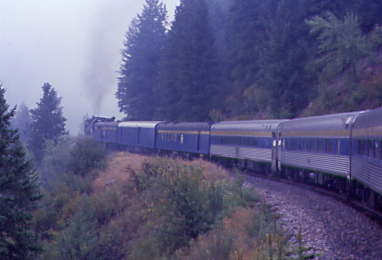
Starting to ascend the grade.
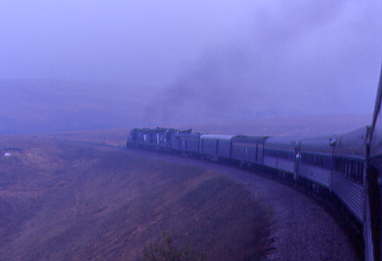
Curving higher and higher to gain elevation.
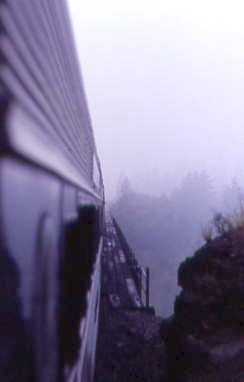
Climbing Evaro hill into the smoke and clouds on a steady climb with our two SD19-1's working hard. I watched the train round every curve from the vestibule and it was an incredible ascension.
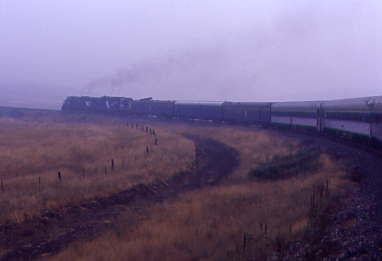
We crossed the line's highlight at Milepost 7.2, the 797 foot Marent Trestle, which took us 226 feet over Marent Gulch. This is the third highest trestle in North America.
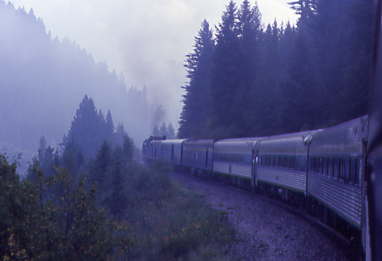
We entered the forest as the canyon narrowed through a passage in the mountains which blocked the clouds and smoke below, making for an interesting scene. As we crested Evaro Hill, Milepost 10.6, at 3,908 feet, the sun returned for the first time since Mullan Pass yesterday.
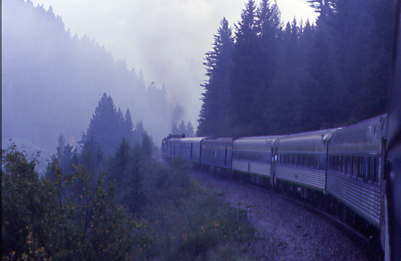
The Montana Dayight climbing through the smoke and clouds.
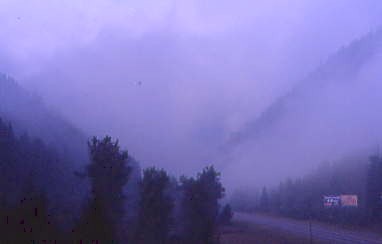
Looking back, you could see the smoke layer trapped by the clouds.
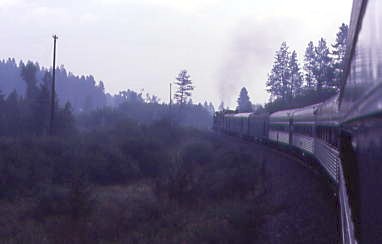
The train still rising as the smoke was less and the sky was turning brighter.
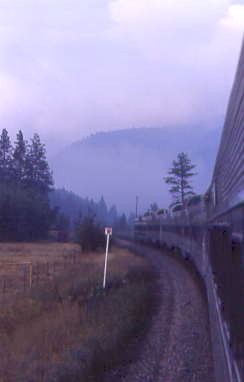
Looking back and seeing what I had been breathing while I took those pictures.
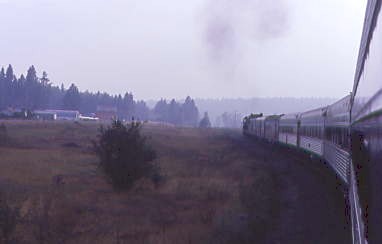
The Montana Daylight crested Evaro Hill.
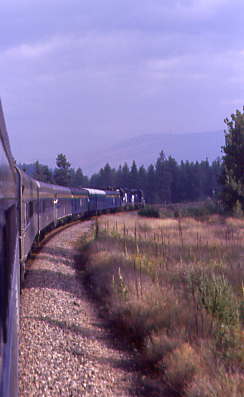
Descending off Evaro Hill.

The station at Dixon, Milepost 37.9.
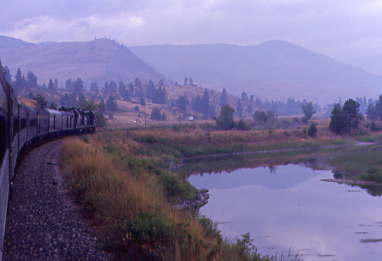
Curving along Jacko River.
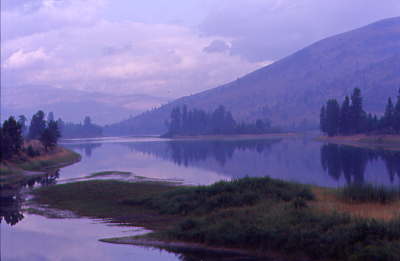
With its ever-changing views, the Montana Daylight passed through Arlee, at Milepost 21.1, crossed the beautiful Jacko River then travelled through the community of Ravalli at Milepost 30.8. The Jacko River was bridged again further west and north of the railroad was the southern boundary of the National Bison Range from Milepost 31 to Milepost 37. We reached Dixon prior to our route being joined by the Flathead River.
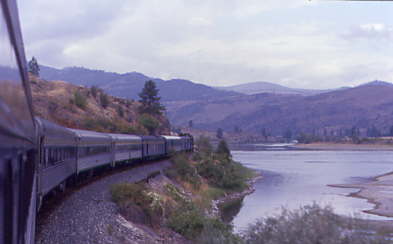
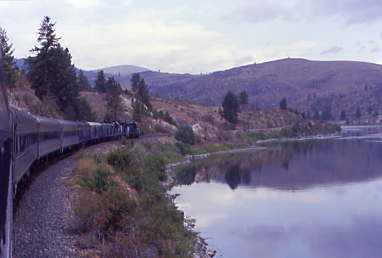
More of the beautiful running along the Flathead River, which drains the western slope of Glacier National Park and the Flathead National Fores,t then enters Flathead Lake before exiting that lake to flow to here.
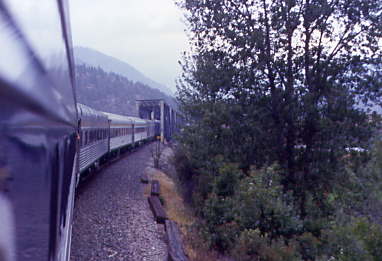
Our train's only crossing of the Flathead River at Milepost 55.2.
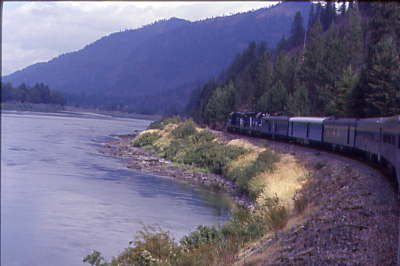
Running along the north side of the Flathead River.

The wall was built by the Chinese when they constructed this part of the railroad in the early 1880's.
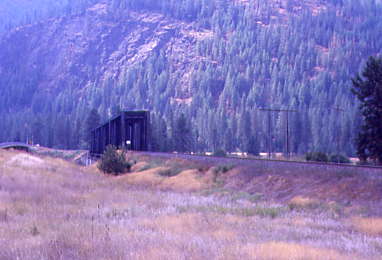
Our route was joined by the line that runs through St. Regis, that we last saw at De Smet and I hoped we would return via that route. We followed the Flathead River west to Paradise, stopped to inspect the train and while there, spotted three grizzly bears across the river climbing the steep slope. Further west, the Mission Mountain Range came into view as the train snaked through some curves above the Flathead River before Perma at Milepost 51.6.
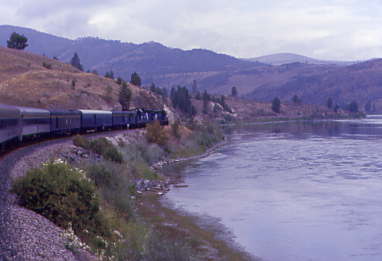
We crossed the Flathead River at Milepost 55.2 on a four-span through pin connected truss bridge built in 1896. It was refurbished in 1945 and is 720 feet long.
Down the rails at Milepost 62.5, we slowed for the stone walls and ovens that the Chinese had built when constructing the railroad. A few minutes later, we were held short of Paradise where the line we left at De Smet returned to our route as the Loram ballast cleaning equipment proceeded toward St. Regis on that line.
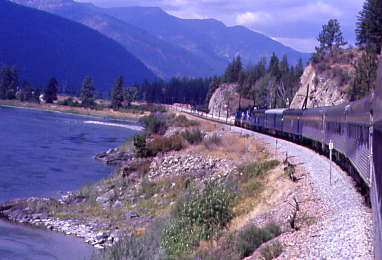
The Montana Daylight running along the Clark Fork River. Once we received a green signal, we departed Paradise, Milepost 64.2, with its small rail yard and lunch was served. Today it was food I could eat, pork and oven-roasted potatoes with a roll and cake, with salad was also provided. All in all, it was a tasty meal. We travelled through Plains, Milepost 6.0 and Weeksville, Milepost 13.5, as the Clark Fork River Valley expanded with the occasional protrusion of rock narrowing it and bringing the tracks back along the river.
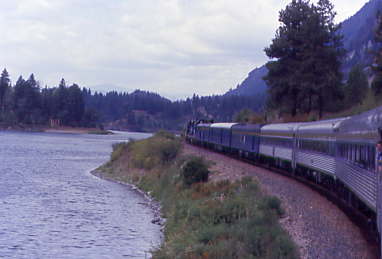
We travelled through Eddy, Milepost 20.5, and at Milepost 26.2, crossed the Thompson River entering from the north. At Milepost 28.1, Woodlin had several local industries and at Pipeline, Milepost 29.2, we went by the Conoco/ Yellowstone Pipeline Terminal which opened in 1995.
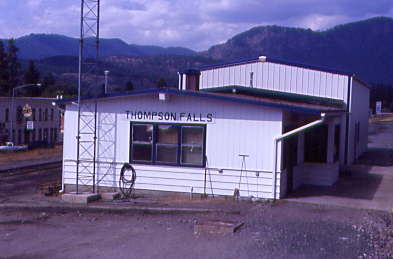
The Northern Pacific Thompson Falls station at Milepost 31.5. Our train next travelled through the town of Thompson Falls, named for David Thompson, an early very prominent British explorer and Northwest Fur Company employee who traded in the area in 1809. This is also the location of the Thompson Falls Dam and hydro-generating facility.
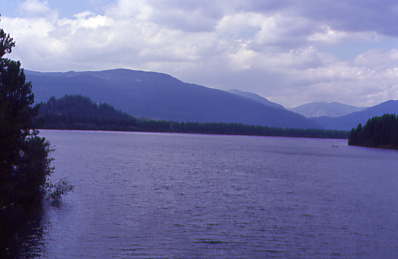
Crossing the Clark Fork River for the first time today at Milepost 36.7, we then ran through the forest to Childs, Milepost 46.4 and Trout Creek, Milepost 54.0, with just a few views of the river in this section of our journey. We came to the upper reaches of the Noxon Reservoir, which required a 16.8 mile line change from Milepost 56.8 to Milepost 73.6 in 1957.
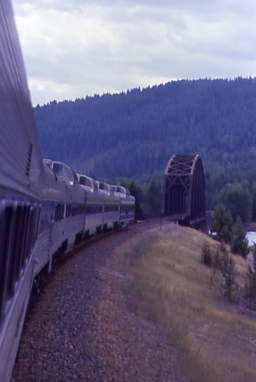
The Montana Daylight travelled through Tuscor, Milepost 61.6, then crossed McKay Creek at Milepost 62.4 and Rock Creek at Milepost 67.2.
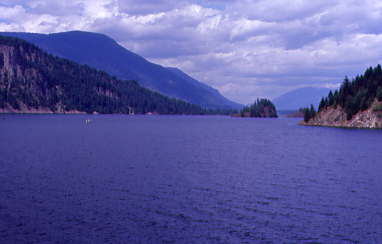
The scenic Noxon Reservoir with its Noxon Rapids dam and power plant near Milepost 66 through the trees. To our north were the Cabinet Mountains, while on our south were the Bitterroot Mountains, whose summits make up the Montana/ Idaho border. We ran along the Cabinet Gorge Reservoir to Milepost 73, but the forest blocked most of the view. Heron, Milepost 80.1, was the site of a line relocation which caused the siding to be separated from the mainline by a hundred feet to the north. We left Montana and entered Idaho, passing the back of the Cabinet Gorge Dam and Power Plant at Milepost 73.
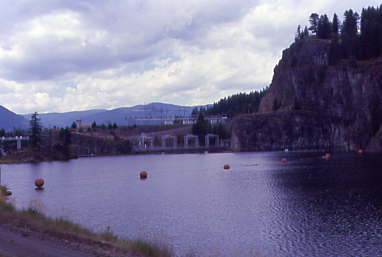
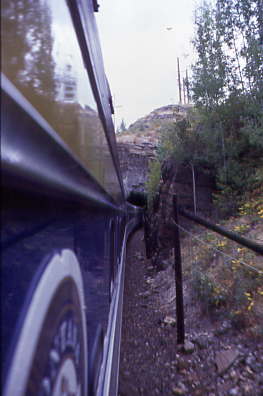
We entered the Cabinet Tunnel at Milepost 85.9, a 365 foot bore built in 1882, the last tunnel on our westward trek.
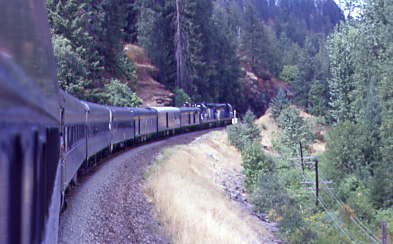
Curving through Idaho.
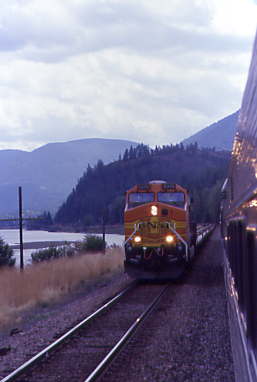
Being passed by BNSF 5308, a baretable train that we passed in Missoula this morning. Someone must have needed those empty piggyback cars in a hurry.
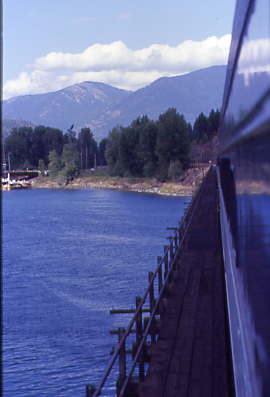
Our last crossing of the Clark Fork River at Milepost 92.7 on a 1,174 foot deck plate girder completed in 1955 as part of a line relocation. The old railroad bridge is now a highway bridge off to the south and slated for replacement. We then went through the town of Clark Fork at Milepost 83.8 before crossing Lightning Creek at Milepost 94.4.

West of here, we started to follow Lake Pend Oreille (pronounced pond-or-ay).
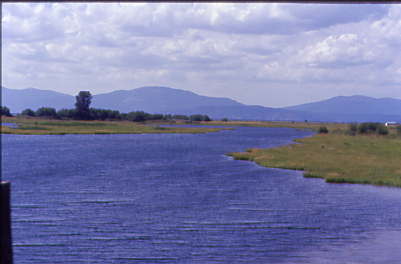
Wetlands were prevalent in the area.
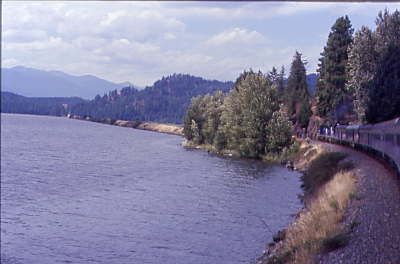
Approaching the causeway across Lake Pend Oreille.
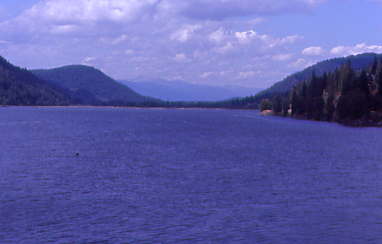
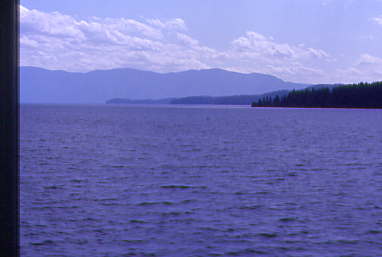
Northern and southern views.
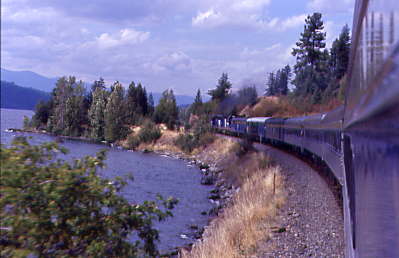
Once Highway 202 crossed over us, we started our shoreline running.
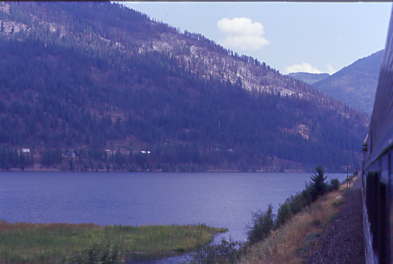
One last looking back across the causeway, after which we travelled through the town of Hope, Milepost 103.5 with its houseboat marina, crossed Trestle Creek at MP 106.5 then the final highlight of our trip west, the second causeway across the beautiful Lake Pend Oreille, which was really spectacular and lived up to everything I had heard about it. Absolutely fantastic is how I would sum it up.
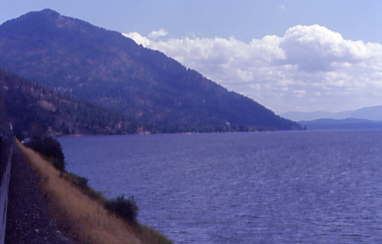
We proceeded inland with only a few glimpses of the lake.
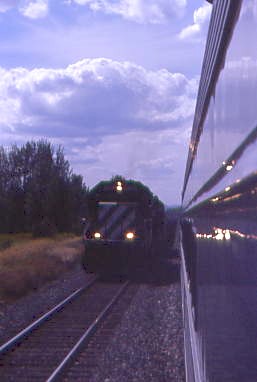
We ran to Kootenai, Milepost 117.0 and met BN 8004 East, then entered the passing track, going by a car used for parts and another one being restored. We reversed into the storage track, completing our westward rail journey on the Montana Rockies Daylight.
My mother told me the onboard service was up to the standards of Virgin Airlines, provided by Casey, Laura and Hunter, our car attendants, Ian our bartender, Dave Taylor, our most wonderful PA announcer and Mike Phillips, our train manager. The entire train crew who served us did so always with a smile and were at the ready to serve everyone. The Montana Daylight is a first-class operation in all ways and I could not wait for our next two days going east to start.
Daniel's group was first to detrain and we were taken to the La Quinta Inn in Sandpoint, while the majority of the bus stayed on to go to Spokane. There would be eight of us making the complete round trip back to Livingston.
Sandpoint 8/23/2003We were given our keys and went to our room. I walked down to First Avenue to Image Maker Photo and Video for four more rolls of slide film then went to Super Food to get more film for my mother. The two of us then walked a block to the Sandpoint Cinema to see Jackie Chan in "The Medallion". The movie was excellent and it was the first time Jackie used wires in some of his fight scenes and did an open mouth western kiss. We had been given restaurant suggestions by Bill, our narrator so afterwards, went to the Sand Creek Grill for dinner.

Sand Creek as we walked to the restaurant.
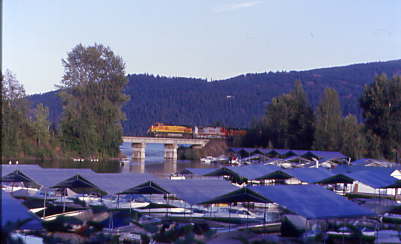
An eastbound BNSF train while we were dining. There were a total of four trains.
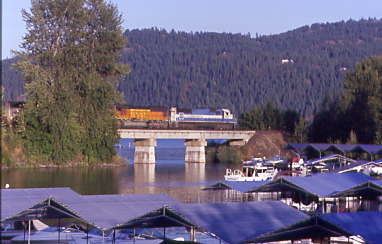
Later, a westbound passed through. We sat outside on the deck overlooking Sand Creek with the marina and the BNSF bridge over the opening to the harbour. This is the Funnel as it carries all BNSF and MRL traffic for Sandpoint Junction and Spokane, up to sixty trains a day.
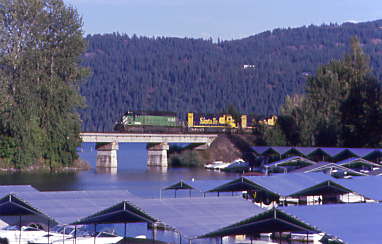
After dinner, we walked over to Bridge Street and found the Amtrak station in the former Northern Pacific depot then returned to to the hotel through the Clear Creek Store. Back in the hotel room, I caught up the story while watching "Triple X" before calling it a night.
8/24/2003
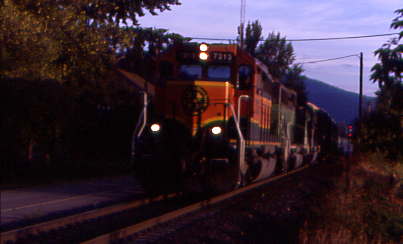
Up early, I walked down to Lake Pend Oreille and on the way, caught a westbound BNSF freight passing the depot.
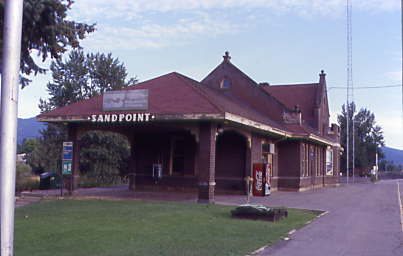
Northern Pacific Sandpoint station built in 1916. In 1882, the Northern Pacific Railroad rumbled to a stop here. The arrival opened a trade route for timber from North Idaho to the east coast and freight to the west coast. Passengers arrived and small communities sprung up along the tracks. The railroad was a driving force behind the settling of North Idaho.
The original station sufficiently handled the needs of the growing community. The wood frame combination freight house and passenger depot was built on the east side of the tracks between the railroad grade and Pend Oreille Lake. Sandpoint had sprung up along both sides of the Northern Pacific tracks. The town was built from the plentiful timber supplies of North Idaho, and it burned to the ground in 1892, again in 1894 and yet again in 1900. In each fire, many of the businesses were destroyed. By 1914 the majority of the town moved to the west side of Sand Creek leaving only the depot, a few businesses and the “Restricted District” or Red Light area on the east side of the creek. The depot was moved to the west side of the railroad tracks at the base of Cedar Street Bridge.
In 1915 a prosperous and growing Sandpoint decided a fancier depot was needed, so as to impress arriving travellers. Rounds Construction Company of Seattle designed the current one-story brick building, the only gothic-style railroad depot in Idaho. The brick gables at the ends of the roof are accented by arched, pointed windows and topped with stone spheres. The dormers and bay window are off center, adding to the character of the building. The depot contained a waiting room, ladies restroom, a smoking compartment for men and several offices. The outside was lighted by cluster lights and 8 posts with large candle power along the brick platform.
The construction company used 70,000 "common" bricks from the Anderson Brick Company west of Sandpoint and 1,200 bags of Lakeview cement, 16,000 "facing" bricks and the deep red roofing tile from Spokane. The interior featured white enameled brick, heavy oak timber and terrazzo flooring. The wood plank platforms were replaced by Lakeview cement.
The depot has served the community for a century and is the last standing structure of the original town of Sandpoint. With the Sand Creek Bypass, Amtrak felt the depot would be compromised and considered abandoning this depot and building a new one outside of town. Instead, Amtrak and Idaho Transportation Department reached an agreement to refurbish the depot and keep it open.
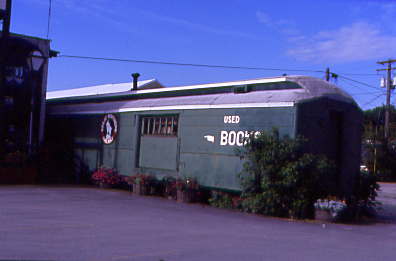
In a case of you never know what you are going to see on a trip, this heavyweight Great Northern baggage car was part of a book store at Fosters Antiques across the street from the hotel. I made my way to the lake to collect some sand for Mrs Angle, the best science teacher I know, to add to her collection.
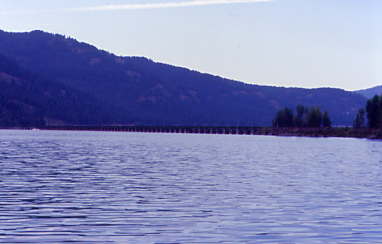
I walked out to the southeast breakwater and heard an eastbound freight coming on a long bridge over another arm of the lake that the BNSF uses to get into town. The freight stopped in the siding just before the bridge and waited for twenty-five minutes, but it never moved. Here was the scene for the picture I wanted; renting a boat would be a good idea for a future trip. I went back to the hotel and when we went to Connie's for breakfast, I saw a westbound BNSF freight that my eastbound across the lake had been waiting for.